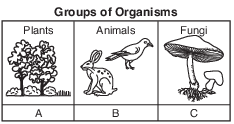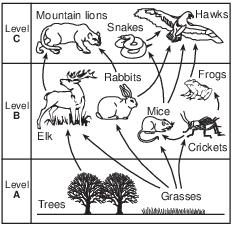Topic: Materials Cycle Through Ecosystems
Materials Cycle Through Ecosystems
Which statement best describes an ecosystem maintaining a state of approximate equilibrium?
(1) Nutrients from decayed organisms are recycled in a forest ecosystem.
(2) All the frog species in a South American rain forest become extinct.
(3) A mutation spreads through a species of bacterium, making them unable to decompose wastes.
(4) Mice are released into a field ecosystem as food for a declining predator population.
The chart below represents some of the events
that occur during the cycling of nutrients in an ecosystem.

Which organisms would most appropriately complete the chart when written in the circle at X?
(1) producers
(2) herbivores
(3) carnivores
(4) decomposers
Which group of organisms in an ecosystem fills the niche of recycling organic matter back to the environment?
(1) carnivores
(2) decomposers
(3) producers
(4) predators

Which statement correctly describes an interaction that contributes to the stability of this ecosystem?
(1) Species E is not affected by the activity of species A.
(2) Species B returns compounds to the environment that may later be used by species C.
(3) Species C recycles nutrients from species B and D to obtain energy.
(4) Species D is directly dependent on the autotrophic activity of species B.
The diagram below does not represent a sustainable energy pyramid in an ecosystem because

(1) energy is never transferred between levels in ecosystems
(2) ecosystems never have more than three levels of energy transfer
(3) more energy must be available in the producer level than in the consumer levels
(4) producers feed on herbivores in most ecosystems

If the amount of carbon dioxide in the atmosphere were to decrease, which organism in the diagram would be one of the first affected by this change?
(1) hawks
(2) wheat
(3) locusts
(4) molds
Four levels of an energy pyramid are represented below.

Which statement about this energy pyramid is correct?
(1) Organisms in level 4 receive their energy directly from the Sun.
(2) Organisms in level 2 are carnivores.
(3) Organisms in level 2 receive their energy from level 3.
(4) Organisms in level 1 are autotrophic.
Carbon dioxide and oxygen are important resources in ecosystems and are
(1) recycled through the activity of living and nonliving systems
(2) stored in the animals of the ecosystem
(3) lost due to the activities of decomposers
(4) released by the process of photosynthesis
Which type of organism helps to reduce atmospheric carbon dioxide?
(1) carnivores
(2) producers
(3) decomposers
(4) herbivores
Which level of the pyramid below is correctly paired with the type of organism that would most likely be found at that level in an ecosystem?

(1) Level A – producers
(2) Level B – carnivores
(3) Level C – herbivores
(4) Level D – decomposers

Explain the role of these groups of organisms in the cycling of materials and the transfer of energy in an ecosystem. In your answer, be sure to:
• explain why an ecosystem requires a constant input of energy [1]
• explain how organisms in group B obtain energy [1]
• explain the role of organisms in group C in the ecosystem [1]
• identify the process used by all three groups of organisms to make energy available to their cells to carry out life functions [1]
The student’s response to the bulleted items in the question need not appear in the following order.
• 11 Allow 1 credit for explaining why an ecosystem requires a constant input of energy. Acceptable responses include, but are not limited to:
• — Energy is always lost as it is transferred through the ecosystem.
• — Energy is continuously needed for metabolic processes.
• — It is needed so that autotrophs can make food.
• 12 Allow 1 credit for explaining how organisms in group B obtain energy. Acceptable responses include, but are not limited to:
• — Some group B animals eat group A plants.
• — Organisms in group B obtain energy from organisms in group A when they eat them.
• — Group B eats plants, fungi, and/or other animals.
• — The animals eat the plants.
• — They obtain energy from their food.
• 13 Allow 1 credit for explaining the role of organisms in group C in the ecosystem. Acceptable responses include, but are not limited to:
• — Organisms in group C break down dead organisms and return nutrients to the soil.
• — Group C returns raw materials to the ecosystem by decomposing dead organisms.
• — These organisms are decomposers who recycle nutrients in the ecosystem.
• 14 Allow 1 credit for identifying the process used by all three groups of organisms to make energy available to their cells to carry out life functions as respiration or cellular respiration.

Explain why there is a different amount of energy represented at each level of this energy pyramid. [1]
Allow 1 credit. Acceptable responses include, but are not limited to:
• — As energy is transferred at each feeding level, some is lost as heat.
• — Some of the energy is lost at each step of the energy pyramid.
• — About 90% of the available energy is lost at each feeding level.
• — Some energy is used for life functions.
• — At each level, only about 10% is passed on to the next level.
People who live in rural areas often use septic tanks for the storage of sewage. These people often flush a product containing harmless bacteria down the toilet once a month. These bacteria break down the sewage before it enters the environment. State one ecologically sound reason for this action. [1]
Allow 1 credit. Acceptable responses include, but are not limited to:
• — It helps recycle molecules from the organic wastes.
• — They prevent the buildup of human sewage.
• — It prevents contamination of the water supply.

State one reason why there is less energy available at each trophic level going from the first to the third trophic level. [1]
Allow 1 credit. Acceptable responses include, but are not limited to:
• — Energy is lost at each level as heat.
• — Some energy is used by the organisms at each level and is not available to the organisms at
• the next level.
• — Energy is lost.
Snowy Owls Move to the South
Snowy owls are large white birds that normally inhabit the cold northern regions of Canada. Recently, scientists and birdwatchers have sighted the snowy owls much farther south than usual.
When snowy owls are in northern areas, they feed on lemmings (small rodents). When lemmings are not available, as in the areas further south, the owls will seek out mice or rabbits as their food source.
Several snowy owls migrated into an area represented by the food web below.

State which level, A, B, or C, contains the least total available energy. Support your answer. [1]
Level:
Allow 1 credit for stating level C and supporting the answer. Acceptable responses include, but are
• not limited to:
• — At each level, as you go up from the plants to the herbivores to the carnivores,
• energy is lost.
• — Energy enters the ecosystem with green plants capturing energy from sunlight.
• There is less energy available as it is passed on to the consumers.
• — Energy is lost at each feeding level.
